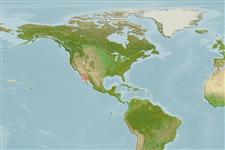Environment: milieu / climate zone / depth range / distribution range
Écologie
marin benthopélagique. Subtropical; 33°N - 25°N
Eastern Central Pacific: Gulf of California.
Taille / Poids / Âge
Maturity: Lm ? range ? - ? cm
Max length : 46.0 cm TL mâle / non sexé; (Ref. 2272)
Forms big schools in shallow rocky areas that are rich in algae. Feeds on algae and small invertebrates.
Life cycle and mating behavior
Maturities | Reproduction | Spawnings | Egg(s) | Fecundities | Larves
Sommer, C., 1995. Kyphosidae. Chopas. p. 1195-1200. In W. Fischer, F. Krupp, W. Schneider, C. Sommer, K.E. Carpenter and V. Niem (eds.) Guia FAO para Identification de Especies para lo Fines de la Pesca. Pacifico Centro-Oriental. 3 Vols. FAO, Rome. (Ref. 9310)
Statut dans la liste rouge de l'IUCN (Ref. 130435)
Menace pour l'homme
Harmless
Utilisations par l'homme
Outils
Articles particuliers
Télécharger en XML
Sources Internet
Estimates based on models
Preferred temperature (Ref.
123201): 22 - 25.1, mean 23 °C (based on 54 cells).
Phylogenetic diversity index (Ref.
82804): PD
50 = 0.5000 [Uniqueness, from 0.5 = low to 2.0 = high].
Bayesian length-weight: a=0.01479 (0.00671 - 0.03258), b=3.08 (2.89 - 3.27), in cm total length, based on LWR estimates for this (Sub)family-body shape (Ref.
93245).
Niveau trophique (Ref.
69278): 2.8 ±0.26 se; based on food items.
Résilience (Ref.
120179): Milieu, temps minimum de doublement de population : 1,4 à 4,4 années (Preliminary K or Fecundity.).
Fishing Vulnerability (Ref.
59153): Moderate vulnerability (36 of 100).
Nutrients (Ref.
124155): Calcium = 61.7 [32.7, 102.5] mg/100g; Iron = 0.812 [0.481, 1.384] mg/100g; Protein = 17.9 [16.8, 18.9] %; Omega3 = 0.206 [0.114, 0.373] g/100g; Selenium = 23.8 [10.5, 50.8] μg/100g; VitaminA = 11.7 [3.1, 41.3] μg/100g; Zinc = 0.846 [0.599, 1.266] mg/100g (wet weight);
